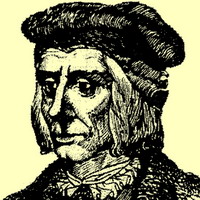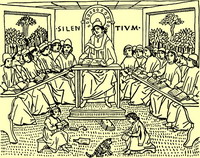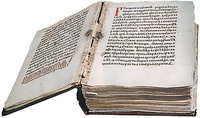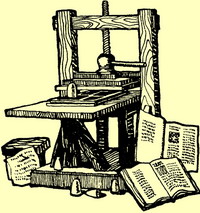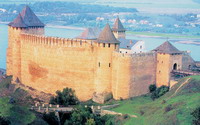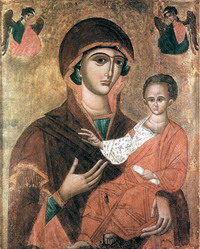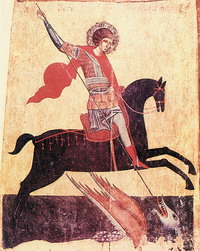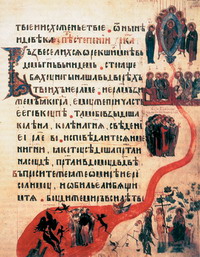Cultural life in the second half of 1914 - early 16 th century.
Plan presentation
- Terms of culture.
- development of Ukrainian language.
- Folklore.
- Education.
- Beginning Ukrainian publishing.
- chronicle.
- Architecture and urban planning.
- Visual Arts.
basic concepts and terms
incunabula (from Lat. incunabula - the cradle), called the books published in the mid 15 th century. in 1500, books that were published from 1501 to 1551, - paleotyps . Under-age following the publication - up to 1800 called ancient .
iconostasis - wall partition separating the altar - the main place in the temple, the central parts - a room where there are believers. Consisting of one or two rows of icons. Over time, the number of tiers in the iconostasis increased to four.
Ballads - genre of lyrical poetry, fiction epic, heroic historical or social content community of dramatic plot.
Historical songs - lyrical epic folklore about specific historical events and historical processes of .
Thinking - usnopoetychni heroic works of important events and prominent figures in Ukrainian history, which napivprospivuvalys napivpromovlyalysya-under musical suppovid on bandupi, Kobza lipi or traveling singers.
Kobzar - The traveling singer who sang songs and played Kobza (or lyre Bandura).
Personality
 Drogobych Yuri (ca. 1450 - 1494) - Ukrainian scientist. He published the first of a Ukrainian his work in Europe in the days when printing only engendered. He is one of Ukrainian students, became the first doctor of medicine and professor of the University of Bologna in Italy.
Drogobych Yuri (ca. 1450 - 1494) - Ukrainian scientist. He published the first of a Ukrainian his work in Europe in the days when printing only engendered. He is one of Ukrainian students, became the first doctor of medicine and professor of the University of Bologna in Italy.
Yuriy managed
Born in a family burgher Michael Donat. Last Kotermak it was, however, following the then custom imenuvav scientist himself by name hometown.
having received a primary education, curious young man was not leaving education. Learn more he went to Cracow University. Already there showed considerable ability and hard work, becoming one of the few among the students of Bachelor of fellow students and a year later - the master. By this he went to continue their studies to the famous University of Bologna. Krakow Yuriy managed to return a recognized scholar in Europe. Researchers believe that his lectures on astronomy and medicine listened Nicolaus Copernicus - astronomer then outstanding reformer.
Yuriy managed was the author of one of the earliest printed books. His treatise "current prognostic assessment in 1483 was printed in Rome on February 7, 1483 According to researchers, a small number of copies of the book was several hundred copies.
main presentation
1. Conditions of Culture
- Ukrainian Culture 15 - the first half of the 16 century. - The direct successor to the culture of Kievan Rus and Galicia-Volyn principality.
- Ukrainian lands were within the several states, because the conditions for Ukrainian cultural progress, which occurred in those states were unequal.
- Favorable conditions were in the Grand Duchy of Lithuania. Putting the Ukrainian-Ruthenian land Lithuanian princes sought to join the great culture of Kievan Rus, the wealth which is not rejected, and supported and vidrodzhuvaly with the Orthodox faith and Ruthenian language that were considered state.
- Lithuanian nobles and took over for traditional Russia-Ukraine lifestyle.
About - Polish kingdom, the researchers say that it was the gate through which ideas to Ukraine dolynaly Renaissance , assuming spreading Western education system.
- not having our own high school, Ukrainian studied in European universities, there pryluchayuchys to Western scientific and artistic ideas, enriching their own culture.
- Ukrainian who gained their education in Western Europe, insisted on their national origin, adding to their names the words « Rusin » , « roksolanyn », « rutenets », is Ukrainian.
- However, please note that the wave of Western European cultural influences swallow the age-old traditions.
- new and old in the Ukrainian culture coexisted peacefully, nasharovuyuchys each other.
Consequently - faced unique cultural phenomenon.
2. The development of Ukrainian language
- from Kievan Rus tradition of the two literary languages: portrait old Ukrainian language and Ukrainian version of tserkovnoslov ' Slavic languages - language slov'yanoruskoyi .
- Old Ukrainian language was close to spoken language.
- Monuments official-business style languages preserve many old Ukrainian dialectal phenomenon eloquently pointing to the place of creation.
- Church will continue to write books in Church Slavonic language which they called slov'yanoruskoyu.
3. Folklore
- Folklore developed on the basis of old traditions rooted in ancient times.
- Yet within days there was a pagan folklore, poetry.
- Ancient Spring, Christmas carols in the living folk memory, gaining time new content.
In the old stories - vplitalysya new heroes, new events generated by inhabitants of historical conditions. For example, the hero of many a youngster Christmas carols - the winner in the battle against ordyntsev.
- of 14 - 15 centuries. fast ice formation usnopoetychnoho genre historical songs and Ballads .
- oldest record of Ukrainian historical songs, ballads, preserved - lyrics "Danube, Danube smuten techesh why?", inserted in manuscript "Czech grammar" Blahoslava Jan 1571
- most valuable artistic heritage of the peoples of those times were thoughts , which as far back princely times.
- great importance in the performance of doom took on improvisation - in other words, created the Duma during each performance, remained unchanged at this issue and the main elements of the plot.
- earliest thoughts emerged in 14-15 centuries. They show a severe poverty and misery of the Ukrainian people caused by the horde raids, the horrific destruction of towns and villages cruel havoc, destruction and mass enslavement Ukrainian.
4. Education
-
 Traditionally education acquired by churches and monasteries.
Traditionally education acquired by churches and monasteries.
- Specially trained clerics, called the grammar or scribes, taught children writing Church Slavonic, the beginning of arithmetic, prayers and singing.
- existence of a network of primary schools in Ukraine confirms the fact that many Ukrainian studying in European universities since the beginning of their existence. But to become a student had to have basic knowledge.
5. Beginning Ukrainian publishing.
- first printing, books which had been popular in Ukraine, appeared in late 15 th century. in Krakow. He founded it Shvaypolt Fiol .
It is believed his - Ukrainian pioneer. In 1491 he published four books in Church Slavonic liturgical language epilogue is Ukrainian, and indicates that customers knyhodrukiv.
- appearance in Krakow those books for the Orthodox Church was outraged by the Polish magnates. Fiol suffered persecution, he was forbidden to print books.
- the early 16 th century. appeared knyhodruky Belorussian Francis Skoryna. In 1517 in Prague, he published the "Psalm" and 1519 - "Bible Ruska.
Books - Francis Skoryna were extremely popular in Ukraine, as evidenced by their handwritten copies.



6. Chronicle
- In our time saved lists chronicles the Grand Duchy of Lithuania.
He - historical piece of literature set in the Chronicles of ancient Ukrainian tradition, but was created by a joint work of Ukrainian, Belarusian and Lithuanian scribes.
- He is known in 3 editions. In the chronicles of the history of Lithuania set forth from ancient times to the mid 16 th century.
- advocacy Lithuanian-Rus is most expressive in "praise the great King Vytautas" that the content and manner of presentation differs from among the text record.
- noteworthy and stories on Podolski land ", which refers to the reign of the second half of 14 century. on the tail of Lithuanian princes, brothers Koriatovychiv.
- significant place in the Ukrainian chronicle those times belonged Volyn chronicle , which is called Short Kyiv .
- compiled directly in Kiev and completed in the early 16 th century. he covered the events of 862-1515 years Among the chronicles especially meaningful stories are those relating to the 1480-1515 biennium events
7. Architecture and urban planning
- In the second half of 14 century. the spread in Ukraine primarily on its western lands Magdeburg law, that was brought closer to the Western Ukrainian city, in town planning began to appear signs regular planning.
- in strict geometric grid placed the main elements of the fortified settlements of new centers - the market square, blocks, streets. Downtown, from which, in fact, began construction was in the middle area of the Town Hall - Market Square.
- This area should form a rectangle or square.
- Major streets were laid across the city. The protective walls of their functions that they obnosyly city, as well as ditches and ramparts.
- Lviv Market Square was built back in the 14 century.
- New central city area of Market Square and surrounding streets covered nearly a square area.
- former princely city suburb of it was (it was called Krakow), which was located on the outside protective walls.
- new city was surrounded by defensive walls.
- At first it has been the only one ring surrounded the walls, a deep ditch and high embankments.
- With the invention of firearms built another wall - external.
In Lviv - ants had two entrance gates, which were deceptive bridges. Protective structures zatyskaly city, so its internal buildings was dense and extremely economical.
- Old cities such as Kyiv, Volodymyr, Chernigov, Novgorod-Seversky, kept an old plan, which is based was entrusted relief peculiarities.
In - outlines cities play a major role are the silhouettes of numerous high towers.
- from one to another tower defense extended Murovanye or wooden walls.
- Moreover, under the constant threat of surprise attack from the steppe rice even acquired defensive architecture of churches, monasteries, synagogues, etc..
- wooden fortress was an essential feature of the lands and Dnieper left bank.
- Wooden fortifications had, in particular, who was Kyiv.
- Kyiv was the biggest castle, built on Castle Hill by Vladimir Olgerdovich.
- Year 1416 Castle could not take forces Edyheya.
- Only in 1482 it was captured and burned the Crimean horde Mengli Gil. Soon the castle was rebuilt.
- Most masonry castle was in Podolia and Volhynia. The most prominent landmark castle-building in Ukraine is Upper Castle in Lutsk.
His - built by Duke of Westminster and completed by Svydrygailo.
- Now keep touch of bygone times glorious Ostrog castle . Late 15 - early 16 th century. it was rebuilt: wooden and earthen fortifications mostly replaced by brick buildings.
- Among the many defensive structures skirts one of the most impregnable fortress was considered Kamjanetsky , built on high rocky banks of the river canyon.
- characteristic architecture of that period was Medzhybizh Castle .
- He had a regular shape, as plan-Podilski fortress, as it takes into account possible environmental conditions.
- Castle stood on a high promontory, where merging the Southern Bug and Buzhok.
- from the end of 14 century. from the reign of Theodore Koriatovycha Transcarpathia traces its history is best preserved in the land Mukacheve Castle .
- One of the strongest defensive structures was Belgorod-Dniester (Akermanska) fortress , the oldest part of which was built in the 13 - early 14 century.
- In the second half of 15 century. significant restructuring were conducted in Khotyn fortress - impregnable fortress in the middle flow of the Dniester.
- large monasteries sometimes acquire the appearance of real castles protected by strong walls with towers.
- This, in particular, of Church (Assumption) Monastery-fortress in the village in Volhynia Zymne (late 15 th century.).
- unique, highly distinctive landmark 15 th century Ukrainian architecture. Intercession is a church-fortress in the village Sutkivtsi in Podolia. Through Sutkivtsi goes way almost every year horde had marched for prey, and only gave the church to help people escape.






8. Visual Arts
 English
English
 Drogobych Yuri (ca. 1450 - 1494) - Ukrainian scientist. He published the first of a Ukrainian his work in Europe in the days when printing only engendered. He is one of Ukrainian students, became the first doctor of medicine and professor of the University of Bologna in Italy.
Drogobych Yuri (ca. 1450 - 1494) - Ukrainian scientist. He published the first of a Ukrainian his work in Europe in the days when printing only engendered. He is one of Ukrainian students, became the first doctor of medicine and professor of the University of Bologna in Italy. Traditionally education acquired by churches and monasteries.
Traditionally education acquired by churches and monasteries. 













